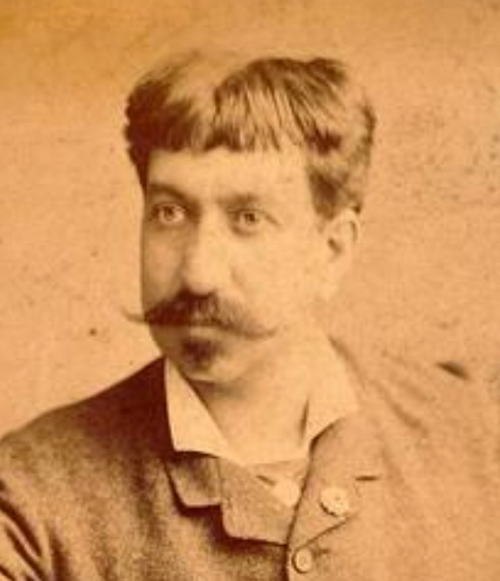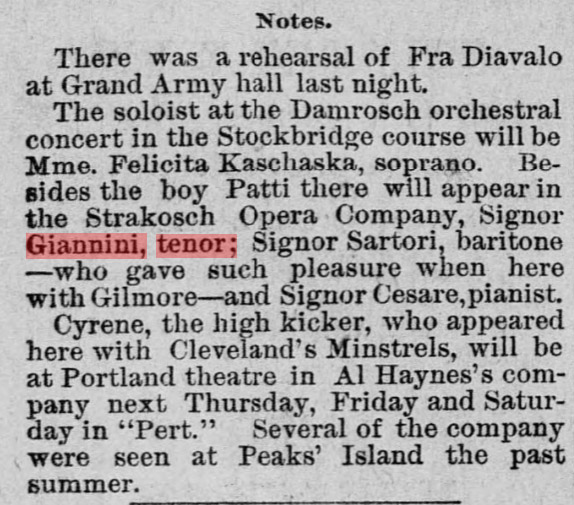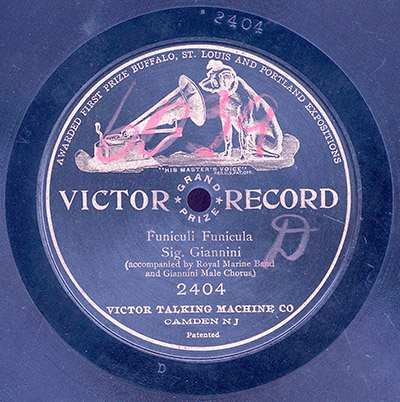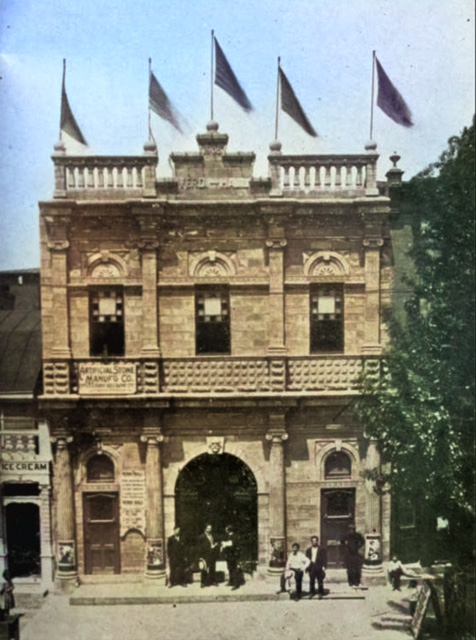Ferruccio Giannini
15 November 1868 Ponte all'Ania – 17 September 1948 Philadelphia

In RA format
Ferruccio Giannini's importance rests upon the fact that his Berliner recording of "La donna è mobile" of January
21st, 1896, is considered to be the first commercial operatic record ever made. And he was maybe the first operatic "record
star" – remember, here we're talking about a time when records were sold in bicycle shops! He made about 180 recordings,
even in post-bicycle times (until 1913).
He emigrated to the USA at 17 years old with his parents. Most everything you read about his
career is just plain wrong, for a simple reason: the name Giannini is too frequent, and if newspapers, as it was the
case, habitually just write "Signor Giannini", and you have three or four tenors of that name, all active in the US at the
same time... confusion is perfect, and will in many specific cases never be redeemed. Even in Roberto Marcocci's chronologies, the various Gianninis have been mixed up sometimes,
and far worse so in Treccani's (usually impeccable) Dizionario biografico degli italiani. Both Treccani and Kutsch &
Riemens know that Ferruccio Giannini studied voice with Eliodoro De Campi (true), but Treccani says it was at the Detroit
conservatory, and Kutsch/Riemens say it was in Boston; however, Eliodoro De Campi never lived in Detroit or Boston – rather,
in New York, then in St. Louis, and from 1878 (so in the period relevant for Ferruccio Giannini) in Chicago.
Kutsch and Riemens say that
Ferruccio Giannini made his operatic debut in 1891 in Boston (for which I didn't find any proof); both Kutsch/Riemens and
the Treccani dictionary think that he sang with various traveling opera companies in the US, particularly the Mapleson
Company – which is definitely wrong. Confusion already set in at Ferruccio Giannini's lifetime: his obituary in the
"Evening Star" even makes him "one of the founders of the old Mapleson Opera Company in New York"!
|
So far, I've traced four tenors called Giannini, a possible fifth and an alleged sixth one. The others (besides Ferruccio)
are:
Francesco Giannini
He was the actual Mapleson tenor. He started his career in Italy, Malta and Greece in the 1870s, then sang a lot in Spain and
Latin America, then with at least four touring companies in the US (Max Strakosch, Milan, Angelo and James H. Mapleson),
then again in Latin America before returning to Europe and singing primarily in Spain and Italy. A (certainly incomplete)
outline of his career would read like this:
1873: Patras, Apollo Theater in November: Norma
1874: Patras, Apollo Theater in January: Barbiere di Siviglia
Napoli, Teatro Mercadante in November: Norma
1875: Napoli, Teatro Mercadante in March: Jone; in June: Poliuto
La Valletta (Malta), Teatru Manoel in October: Jone; in November: Poliuto
1876: La Valletta (Malta), Teatru Manoel in January: Ballo in maschera; in March: Favorite; in December: Trovatore
1877: La Valletta (Malta), Teatru Manoel in March: Favorite
1878: Corato, Teatro Comunale in January: Trovatore; in February: Forza del destino
Milano, Teatro Dal Verme in January: Jone
Novara, Teatro Coccia in March: Favorite
Verona, Teatro Ristori in May: Trovatore
Genova, Politeama in July: Ballo in maschera
Monza, Teatro Sociale in September: Jone
Messina, Teatro Vittorio Emanuele in December: Ruy Blas
1879: Messina, Teatro Vittorio Emanuele in January: Ballo in maschera
Montevideo, Teatro Solís: Trovatore on 17/18/25 May – 12/16 June, Traviata on 22/27 May – 3/15 June,
Faust on 29 May – 1/5 June – 7 September, Juive (Éléazar) on 7/8 June – 1 July, Favorite on 21/24/26 June, Ballo in
maschera on 28 June – 6 August, Ruy Blas on 6/8/13/30 July, Forza del destino on 11/18/20 July – 17 August, Aida
on 1/3/13/15/25 August – 3 September, Lucia di Lammermoor on 6/10 August, Poliuto on 20/24 August, Gemma di Vergy on
22 August, Saffo (by Pacini) on 30 August
São Paulo, Teatro São José in October: Favorite, Forza del destino, Ballo in maschera, Aida, Ruy Blas; in November: Trovatore, Jone, Poliuto
1881: Caracas, Teatro Guzman Blanco in January: Favorite, Trovatore, Ballo in maschera, Jone, Ruy Blas
Zaragoza, Teatro Principal in April: Ballo in maschera; in May: Poliuto
Berlin, Westend (open air?) in August: Trovatore
Berlin, Eisring (open air?) in September: Forza del destino, Ballo in maschera
Baltimore, Academy of Music in November: Traviata, Aida
Philadelphia, Academy of Music in December: Traviata, Aida, Lucia di Lammermoor (Strakosch Grand Italian Opera Company)
Washington, Ford's Opera House in December: Traviata, Trovatore
New Orleans, French Opera House in December: Lucia di Lammermoor, Aida (Strakosch Grand Italian Opera Company)
1882: New Orleans, Opera Theater in January: Aida
New York City, Booth Theater in March: Ballo in maschera, Aida
Chicago, Haverly's Theater in March/April (Strakosch Grand Italian Opera Company)
Philadelphia, Academy of Music in April: Trovatore, Faust (Strakosch Grand Italian Opera Company)
Madrid, Teatro Real in October: Trovatore; in December: Ballo in maschera
1883: København, Kongelige Teater in August: Ballo in maschera; in September: Trovatore
Ciudad de México, Teatro Nacional in December: Trovatore, Norma
1884: Puebla, Teatro Guerrero in January: Norma
Zacatecas, Teatro Nacional in May: Favorite, Aida; in June: Rigoletto, Trovatore, Norma, Ruy Blas
Chihuahua, Teatro Municipal in July: Favorite, Aida
San Francisco, California Theater in July: Aida; in August: Aida, Trovatore, Ruy Blas, Ernani, Traviata, Rigoletto, Ballo in maschera, in October: Barbiere di Siviglia
New York City, Star Theater in October: Trovatore, Aida; in November: Rigoletto, Norma (Milan Grand Opera Company)
New York City, Brooklyn Academy of Music in December: Rigoletto (Mapleson Opera Company)
Philadelphia, Academy of Music in December: Aida, Rigoletto, Norma, Trovatore (Milan Italian Opera Company)
1885: Philadelphia, Academy of Music in January: Aida, Ernani, Lucia di Lammermoor (Mapleson Opera Company)
London, Covent Garden in July: Rigoletto, Trovatore
New York City, Brooklyn Academy of Music in November: Trovatore, Africaine; on 23 December: the American premiere of Manon (Mapleson Opera Company)
1886: Philadelphia, Academy of Music in January: Manon, Traviata, Lucia di Lammermoor, Faust, Rigoletto (Mapleson Opera Company)
San Francisco, Grand Opera House in March: Mefistofele, Africaine; in April: Trovatore
New York City, Brooklyn Academy of Music in October: Jone; in November: Ballo in maschera
1887: Catania, Teatro Bellini in March: Aida
Firenze, Teatro Pagliano in April: Aida
Ciudad de México, Teatro Nacional in September: Trovatore, Aida; in October: Rigoletto, Gioconda; in November: Ballo in maschera
New York City, Brooklyn Academy of Music in October/November: probably Jone, Un ballo in maschera (Angelo Grand Italian Opera Company)
1888: Havana, Teatro Tacon in January: Forza del destino, Poliuto; in February: Ballo in maschera
Messina, Teatro Vittorio Emanuele in December: Poliuto
1889: Messina, Teatro Vittorio Emanuele in February: Ruy Blas
Odesa, Municipal Theater in March: Aida; in November: Ballo in maschera; in December: Rigoletto, Norma
1890: Catania, Teatro Bellini in May: Norma; in June: Aida
Milano, Teatro Dal Verme in May: Norma
Perugia, Teatro Morlacchi in August: Mefistofele
London, Covent Garden in October: Trovatore, Aida; in November: Norma
1891: Ciudad de Guatemala in early fall
Porto, Teatro São João in December: Aida
1892: London, Covent Garden in July: Aida; in October: Trovatore, Cavalleria rusticana; in November: Aida
1893: London, Drury Lane Theater in April: Norma
Cork, Royal Theater in October: Cavalleria rusticana
Birmingham, Royal Theater in November: Cavalleria rusticana
1897: Firenze, Teatro Pagliano in January: Norma
1899: Genova, Politeama in April: Aida
Francesco Giannini, although completely forgotten today, sang a lot with celebrities like Lilian Nordica, Nellie Melba or
Adelina Patti.
"The famous tenor, Sig. Edgardo Giannini" was, with all probability, just a mistake of an Indianapolis journalist in
1886; said "famous tenor" sang there in April with the Mapleson Opera Company at English's Theater in Manon with Minnie
Hauk in the title role – precisely the same company, opera and heroine that had been presented in Brooklyn the previous
December, just that the tenor there was our already familiar Francesco, and not Edgardo.
Enrico Giannini, later Enrico Giannini Grifoni, was Francesco's younger brother. He first shows up in 1882 in Italy.
In 1884, the two brothers were both engaged in Mapleson's touring company; from Mexico, they arrived, together with the
entire troupe, at the US Pacific coast by train in Los Angeles on 13 July 1884, and sang in San Francisco at the California
Theater from August to October. Francesco sang, more precisely (see above); Enrico, in spite of having traveled with the
Mapleson Company, was announced as a member of the "Cambiaggio Italian Opera" when singing at the child birthday party of a
wealthy San Francisco family in early August. A few days later, on 15 August, he appeared as Almaviva for Mapleson, and both
he and the primadonna were such a disaster that they had to be replaced for the next performance (early October) –
Enrico by his
brother who, albeit vocally not quite suited to that lyrical and florid part, was unanimously seen (or heard) as superior to
his younger sibling, whose Mapleson career was obviously over after the Barbiere scandal.
This hardly promising early experience notwithstanding, Enrico Giannini later made an even better career than Francesco. Here
is a rough outline:
1882: Vittorio Veneto, Teatro Sociale in August: Trovatore
Pisa, Teatro Nuovo in December: Rigoletto
1883: Cuneo, Teatro Toselli in March: Rigoletto
1884: Zacatecas, Teatro Nacional in July: Barbiere di Siviglia (Mapleson Opera Company)
San Francisco, California Theater in August: Barbiere di Siviglia (Mapleson Opera Company)
1886: Córdoba (Spain), Gran Teatro in June: Barbiere di Siviglia
1887: Madrid, Teatro Real in October: Gioconda; in December: Crispino e la comare
1888: Barcelona, Teatre del Liceu in April: Gioconda
Madrid, Teatro Real in November: Gioconda
1889: Sevilla, Teatro San Ferdinando in April: Rigoletto; in May: Gioconda
Córdoba (Spain), Gran Teatro in June: Barbiere di Siviglia, Rigoletto
Málaga, Teatro Cervantes in July: Barbiere di Siviglia, Rigoletto
Fiume/Rijeka, Teatro Comunale in October: Barbiere di Siviglia, Rigoletto; in November: Fra Diavolo
Mantova, Teatro Sociale in December: Mefistofele
1890: Mantova, Teatro Sociale in January: Pêcheurs de perles
Bologna, Teatro Brunetti in February: Mefistofele
Perugia, Teatro Morlacchi in September: Mala Pasqua (by Stanislao Gastaldon, yes, of Musica proibita fame – the
same story as Cavalleria rusticana, premiered in April 1890 in Rome, only six weeks earlier than Cavalleria)
1891: Buenos Aires, Teatro Ópera in May: Favorite, Mefistofele; in June: Gioconda; in July: Rigoletto, Puritani (Ferrari Company)
Montevideo, Politeama in August: Rigoletto, Mefistofele; in September: Gioconda
Chicago on 13/21 November: Sonnambula; on 18 November: Dinorah; on 4 December: act 1 Traviata (only that act was given to complete an evening that started
with Cavalleria); on 9 December: gala concert, Giannini-Grifoni participated in the 2nd act of Barbiere di Siviglia (all
Chicago appearances with the Metropolitan Opera New York)
Louisville on 8 December: Sonnambula (Metropolitan Opera New York)
New York City, Metropolitan Opera on 21 December: Sonnambula; on 23 December: Rigoletto
1892: New York City, Metropolitan Opera on 29 January: Dinorah
Albany, Opera House on 30 January: Barbiere di Siviglia (Metropolitan Opera, New York)
New York City, Metropolitan Opera on 9 March: Sonnambula
Palma de Mallorca, Teatro Principal in June: Mefistofele
Senigallia, Teatro La Fenice in July: Gioconda
Venezia, Teatro Rossini in November: Mefistofele
Madrid, Teatro Real in November: Mefistofele
1893: Madrid, Teatro Real in February: Rigoletto
Bilbao, Teatro Arriaga in April: Africaine
Valladolid, Teatro Calderón in May: Rigoletto, Africaine
Roma, Teatro Costanzi in June: Cavalleria rusticana, Sonnambula; in July: Barbiere di Siviglia
Lucca, Teatro del Giglio in September: Manon Lescaut
Moskva, Private Theater in October: Rigoletto; in November: Cavalleria rusticana; in December: Favorite
1894: Moskva, Private Theater in March: Faust
Kyiv, Solodovnikov Theater in March: Barbiere di Siviglia, Rigoletto; in April: Favorite, Cavalleria rusticana, Pagliacci (Canio)
Barcelona, Teatre del Liceu in December: Favorite
1895: Monte-Carlo, Opéra in January: Barbiere di Siviglia
1896: Napoli, Teatro San Carlo in January: Mefistofele; in April: Barbiere di Siviglia
Roma, Teatro Costanzi in November: Bohème
Parma, Teatro Regio in December: Andrea Chénier
1897: Parma, Teatro Regio in January: Andrea Chénier
Parma, Teatro Regio in February: Manon, Cavalleria rusticana
Parma, Teatro Regio in March: Cavalleria rusticana
Barcelona, Teatre del Liceu in November: Gioconda; in December: Mefistofele, Carmen
1898: Barcelona, Teatre del Liceu in January: Manon, Traviata
Wien, Carltheater in April: Barbiere di Siviglia, Rigoletto
Barcelona, Teatro Novedades in September: Gioconda; in December: Rigoletto
1899: Buenos Aires, Politeama Argentino in October: Sonnambula
1901: Wien, Carltheater in May: Barbiere di Siviglia
One of the rather puzzling issues about the various Giannini tenors is that in 1934, at the Star cinema in Marseille, the
Italian film "Il Palio di Siena" was shown, and in the intermission, "l'excellent ténor léger Enrico Giannini"
was hugely successful, singing in both French and Italian. If this was "our" Enrico Giannini Grifoni, he would have had a
surprisingly long career... I guess it's rather a random namesake.
Last and least, also Diego Giannini was a tenor, though not an operatic one. He made more than 200 recordings of Neapolitan
canzoni between 1900 and 1924, on G&T, Odeon, Pathé, Phonotype, Columbia, Edison, Favorite and Beka. (The best feature
of his singing is his really authentic Neapolitan dialect.) In 1926, he made
his US debut with the Italian vaudeville troupe of Francesco Iannizza, appearing on stage in the musical comedy in
Neapolitan dialect, 'O schiaffo (very likely in New York City, and definitely in Waterbury at the Teatro Poli).
|
Back to Ferruccio Giannini... His first engagement that I can find (and likely his first ever) was at the World's Columbian
Exposition in Chicago from May to October 1893. "The Morning News" report: "Ferruccio Giannini, the Italian-American tenor,
sang throughout the entire season in the grand administration building, and at the end of his engagement was presented with
a beautiful gold medal, the only one presented to any singer by the exposition company." So obviously, he was a success.
That got his career started, and he immediately embarked on his first concert tour with Gonzales' Mexican Orchestra and
Bianchulli's Italian Gypsy Orchestra ("Great Mexican-Italian Combination", featuring "Ferruccio Giannini, the Peerless Tenor
of the World's Fair").
Still in 1893, he married an Italian violinist, and they moved to Philadelphia, where Ferruccio soon became a fixture in the
city's concert life, and beyond along the East Coast.
There is no proof that he ever sang in opera in those years, however. As I've already said, allegations that he sang with
various touring companies and particularly with Mapleson are simple mix-ups with Francesco and perhaps Enrico Giannini;
Ferruccio Giannini definitely never sang with the Mapleson Opera Company, and proofs for other companies are missing, too. I
found only one opera production where I suspect the tenor could have been Ferruccio Giannini. Could have been! The Portland
Daily Press, in 1892, must have employed a drunkard among their journalists, or the following article could never have been
written:
 Portland Daily Press, 8 October 1892
Portland Daily Press, 8 October 1892
Now this is largely gibble-gabble (two musical events mixed together since Fra Diavolo will certainly have been staged by
the Strakosch Company and not by the Stockbridge course concerts, and certainly one of the silliest mistakes in the annals
of journalism: "the boy Patti"!), so a far less than reliable source; but if at least the tenor's name is given correctly by
the drunk writer, it's none of the usual suspects. Francesco Giannini sang, see above, at Covent Garden that month; and
Enrico had been in Senigallia on the Adriatic coast in July, and would travel from Venice (on the Adriatic coast) to Madrid
in November. How probable is it that he made a quick side-trip to Portland in early October, in the steamship era? Not
overly probable (particularly since Enrico evidently tended to avoid hectic traveling); but also not totally impossible. If
Enrico Giannini stayed put on the Adriatic coast, then "Signor Giannini" in Portland must have been Ferruccio! But I repeat,
this is just an indication – no proof since we don't know for sure what Enrico Giannini did in October 1892.
At the end of the 1890s, Ferruccio Giannini "imported" 60 Italian instrumentalists to Philadelphia and founded
an orchestra, the Royal Marine Band of Italy (first "Banda Rossa" for a short time). It was probably the most successful of
Ferruccio's various enterprises. It toured all over the US, with Ferruccio Giannini always as the sole singer at their
concerts, for instance: Akron (Grand Opera House, May 1899), Butte (Grand Opera House, September 1900), Washington (Olympia
Theater, October 1900), San Francisco (two weeks at the California Theater, November 1900), Worcester (November 1901),
Providence (Opera House, November 1901). When the Royal Marine Band of Italy dissolved after a few years (many of its members
joined the newly founded Philadelphia Orchestra), Giannini went on concert tour with similarly named orchestras, the Marine
Band, Ellery's Royal Italian Band or Ellery's Band.

In 1905, Giannini created his own opera house in Philadelphia: he had Verdi Hall on Christian Street built, in Italian
Renaissance Style as figured by architect Elvin Jackson. The costs almost doubled during construction: projected to be 25'800
$, they amounted to 50'000 in the end. In the basement, Verdi Hall boasted bowling alleys.
At Verdi Hall, Giannini staged vocal and instrumental concerts, commedia dell'arte and – opera; a rarely ambitious
program among the provincial "opera houses" of the day, which were mostly movie and vaudeville theaters, complete with circus
acts, and only the very occasional classical concert.
 Verdi Hall
Verdi Hall
Verdi Hall was singled out by that programming, so there's little doubt that staged opera performances took place there, and
yet very strangely, no specific information as to which operas, when, casts or number of performances are to be found
anywhere. Just Treccani's Dizionario biografico seems to have found information (without saying where) that he performed
35 operas, often with himself as the tenor protagonist.
After the horrible Messina earthquake at the very end of 1908, Giannini staged two dozen sold-out charity concerts in very
short time; Verdi Hall had already been the locale of similar relief activities after the 1906 San Francisco earthquake.
At some point, opera at Verdi Hall seemed too ambitious, though, and Giannini made a cinema of his theater. But at which
point exactly? Depends on whom you ask. Treccani says when World War I broke out; Cinema Treasures, an admirable website on cinema buildings, says Verdi
Hall became a cinema by the end of World War I. However, that doesn't mean that Giannini made it a cinema only; in
September 1920, his daughter Eufemia sang seven classical concerts in a row there.
Yes, his daughter. Ferruccio's and his wife Antonietta's offspring was remarkably musical: son Vittorio became a seriously
successful classical composer; one daughter was Dusolina Giannini, sufficiently famous to need no introduction; the
above-mentioned Eufemia had a short and unremarkable career as a soprano, too, and a long and important one as a voice
teacher at the Curtis Institute, as Madame Gregory (her married name), numbering Anna Moffo, Frank Guerrera and Judith Blegen
among her students.
After Eufemia's short Italian adventure (where she sang opera for a year or so, before coming home when WWI broke out),
Ferruccio started a hugely successful family business: concerts with Eufemia, himself and teenage Dusolina (then still a
mezzosoprano) singing, and either Vittorio playing the violin or his second son Francis playing the cello. For several years,
the Giannini Concert Company would tour the US: Washington (May and June 1918), Harrisburg (February 1919), Wilmington DE
(March 1919), Philadelphia (Metropolitan Opera House, February 1923), Pleasantville (May 1926); over the years, Dusolina's participation became rarer as she advanced with
her vocal studies.
In 1921, Giannini acquired also Cariola Hall, a vaudeville-and-movie theater next door from Verdi Hall. He renamed the
Cariola first D'Annunzio Theater and later Italia Theater. Other than the theater(s), Giannini owned La Tosca Hotel, and a
boarding house for Italian immigrants.
Verdi Hall was a low-cost cinema: admission was cheap, films screened had their third or fourth run, and instead of paying
for newspaper ads, Giannini sent a donkey-led promotional cart along the streets. Sound film and world economic crisis
ruined the business. Giannini did not install a sound system and closed the theater in 1929; the next year, the building was
sold off at a sheriff's sale, and later torn down.
But Ferruccio Giannini continued to run the Italia Theater. He remained in Philadelphia, where he died on September 17th,
1948.
References:
- Dizionario biografico degli italiani, vol. 54, Roma 2000
- Kutsch & Riemens
- Roberto Marcocci
- Will Crutchfield's Teatro Nuovo (where I've also taken the
picture from; this is an absolutely remarkable site because of its "Record of the Week" section, much recommended!)
- Cinema Treasures, where also the Verdi Hall picture comes from
- Opera di Roma online archives
- Mala Pasqua. Libretto, Milano 1890
- Find a Grave (on Eliodoro De Campi)
- La Casa della Musica, Parma
- Teatre del Liceu castlist (Wikipedia)
- Frank Hamilton: Opera in Philadelphia. Performance chronology 1875–1899 & 1900–1924, online publications, 2009
- A. T. Andreas: History of Chicago: from the earliest period to the present time, vol. 3, Chicago 1884, p. 646
- Henry Edward Krehbiel: Chapters of opera. Being historical and critical observations and records concerning the lyric drama
in New York from its earliest days down to the present time, New York City 1911
- Susana Salgado: The Teatro Solís. 150 years of opera, concert and ballet in Montevideo, Middletown 2003
- Manon Lescaut program, Teatro del Giglio, Lucca, 2005/06
- Gesellschaft für historische Tonträger, Wien
- Akron Daily Democrat, 1 May 1899
- The Baltimore Sun, 23 November 1881
- Commercial Bulletin, Price-Current and Shipping List, 14 December 1881
- Daily Alta California, 4 & 16 August/5 October 1884
- Daily Inter Mountain, 29 September 1900
- Daily Los Angeles Herald, 13 July 1884
- Delaware Gazette and State Journal, 14 March 1895
- Evening Journal, 8 March 1919
- Evening Star, 1 December 1881/18 January 1909/28 February 1910/2 June 1918/18 September 1948
- Gazzetta musicale di Milano, 2 November 1899
- Harrisburg Telegraph, 18 February 1919
- Ilustración musical hispano-americana, 15 March 1891
- The Indianapolis Journal, 4 April 1886
- L'Italia, 8 November 1900
- El Liberal, 3 November 1879
- La libera parola, 26 September 1920
- Le Ménestrel, 24 September 1882/5 August 1888/7 November 1897
- The Morning Call, 25 August & 6 September 1891
- The Morning News, 21 December 1893
- Le Petit Marseillais, 9 February 1934
- Le Petit Provençal, 11 February 1934
- The Pleasantville Press, 17 February 1923/21 May 1926
- Portland Daily Press, 8 October 1892
- The Providence News, 16 November 1901
- The Roanoke Times, 13 May & 26 October 1897
- The San Francisco Call, 12 November 1900
- The San Francisco Examiner, 30 September 1884
- The Sunday Star, 2 June 1918
- The Time Dispatch, 6 March 1910
- La Verità, 29 May 1926
- The Washington Herald, 3 March 1910/26 May 1918
- Washington Standard, 26 October 1900
- The Wasp, 26 July/2, 9, 16 & 23 August 1884
- The Wilmington Daily Republican, 3 May 1898
- The Worcester Spy, 15 November 1901
I'm much indebted to Will Crutchfield for patiently correcting my previous mistakes about Ferruccio Giannini, for steering me
into the right direction and for providing me with newspaper clips.
Anton Bieber has provided the Funiculì, funiculà recording and label scan: thank you!
|



